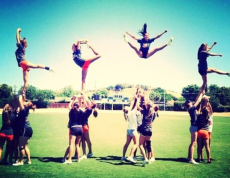
When the topic of cheerleading enters conversation, most think immediately of a group of skinny girls in short skirts chanting and waving pom-poms, at the side of other ‘more important’ sports, but this stereotype is far from the world of cheerleading I have come to know and love over the past year, since I joined my university cheer team. Competitive, or competition cheerleading is based around far more than just cheering, and in fact doesn’t involve another team at all. The cheerleaders are the main focus of the sport and compete against each other in routines involving dance, jumps, tumbles and stunts. Also, the myth that cheerleading is a sport purely for girls is completely unfounded, since even side-line cheerleaders were originally male. But now competition cheer teams rely on a large, strong male half of their team in order to complete harder stunts as well. Male cheerleaders must be agile, muscular and have good endurance too.
The biggest Cheerleading organisation is probably the ICU, International Cheerleading Union, who hold a world cheerleading championship each year between 105 different national cheerleading federations. There are also many national competitions between different types of teams and at different levels of difficulty.
Schools often run their own teams and may compete against each other in their own competitions. Universities can compete in the ICC (International Cheerleading Coalition) Championships which are based mainly in the UK, but under their own sub-section. The championship also features All-Star teams who are not associated with any other establishment, such as schools, but are focused specifically on Cheerleading competitions. If an all-star team is good enough then they may be selected by USASF (the US All-Star Federation) to compete in the Cheer Worlds competition internationally. Aside from the main cheer teams, which are generally comprised of around 30 people, competitions also can include Hip-Hop, Jazz and Pom-Pom Dance teams, as well as stunt teams which are comprised of 5 people and whose routines are solely made up of stunts. Cheer routines are usually about 3 minutes long and are performed to a mash-up of various popular songs, often with sound effects.

A cheer team is generally made up of several stunt teams, each with 5 people; a front base, a back base, two side bases, and a flyer. The various bases work together to lift the flyer into the air in order to perform various stunt sequences. The cheer teams are then judged by a panel, in a similar way to at a gymnastics event, to get a final score. At most competitions, teams are split into various levels, so that only teams on the same level as one another are in competition. The levels correspond to how difficult the stunts in the routines are, so as to make the competition fairer.
Many UK schools are beginning to introduce Cheerleading as an extra-curricular activity, so if you’re interested, maybe give it a try, or if you’re not so interested in the physical side of the sport, maybe just rent a copy of ‘Bring It On’, a popular movie about a high school cheerleading team. Of course, the sport can be very dangerous for flyers and bases alike, but is rewarding when you persevere!
IMAGE 1: http://media-cache-ak0.pinimg.com/736x/11/bd/14/11bd141122fe35173c9f1b7c01972200.jpg
IMAGE 2: http://coffeeandconfettidotme.files.wordpress.com/2014/04/img_9172.jpg?w=640&h=426

0 Comment:
Be the first one to comment on this article.